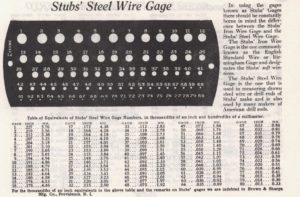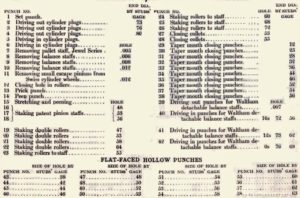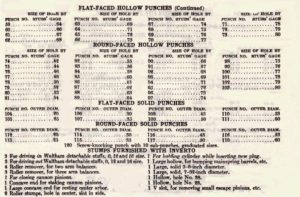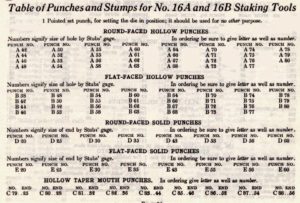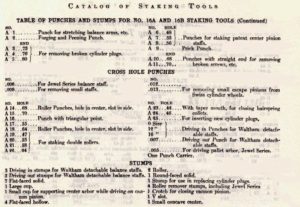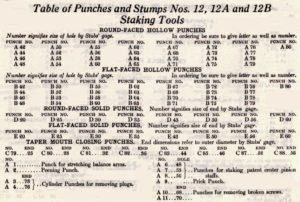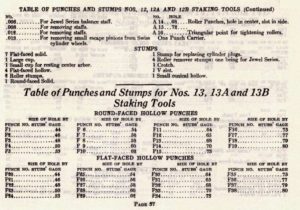Watchmaker Staking Tool Sets
Punches and Stumps Reference
Vintage watch collectors see Kendrick and Davis (K&D) tools as the height of value. because the company revolutionized the repair and service industry with innovations. For example, they invented the Inverto staking frame, canon pinion removers and balance tools. Today, watchmakers like me can use tools K&D made in the early 1900’s especially watchmaker staking tool sets.
The company dominated the market in terms the number of tools sold, and I have their staking tools, bench blocks, balance screw holders and canon pinion removers. Why? I cannot find new tools to accomplish the same tasks.
Before quartz watches and replaceable movements became available, US jewelers and watch companies (like Hamilton, Elgin and Bulova) employed about 65,000 watchmakers. and the United States had robust competitive suppliers called parts houses. Today, only about 1800 watchmakers work in the industry according to Kansas City Federal Reserve Bank. Tool manufacturers just do not find the US market and more.
In the early years, companies innovated, but few made their components backward compatible. Also, documentation doesn’t exist for cross referencing. I searched and found materials for my own use and chose to make them available to my readers.
This article exists to provide you with the various reference numbers of staking set punches and stumps made by Kendrick and David for their respective frames and other tools.
Over their 98-year history, the company made only a few models. You can use the information here to make purchase decisions.
I use preowned watch tools. Hopefully, this information will help watchmakers and collectors identify their holdings.
Kendrick & Davis referred to their first staking set as No. 5 and it came with 32 punches and 8 stumps, which they wrote about in their catalog and said that the 5 and 5B were the same as the Hall Staking Tool. It did not have a die binding mechanism or the sustaining friction sleeve.
K & D produced a second model known as the “New Design” but the new design came in five configurations. They included the following:
No. 12 100 punches, 24 stumps
No. 13 76 ” 20 “
No. 14 60 ” 18 “
No. 15 50 ” 14 “They bundled the Models 12 -15 with a revolving base or a box and also offered a handle, known as an AH. The Model 16 came later with 120 punches and 30 stumps.
Staking Tools and How to Use Them by Kendall & Davis Co. Full 163 Page Version – Adelstein-Workshop
When they changed to their Inverto Models 17 and 18, the frames looked the same as later models having a knurled punch sustainer or knob at the top of the sleeve which secured a punch from moving.
You can find models included the 17, 18B and 18R plus the 600 series still in existence. The box can confuse since most of they have the model 18 on the name plate regardless of what’s inside.
Punches and Stumps
If you buy a staking set, more likely than not, you will find punches of different sizes with different numbering systems. For example, a round face hollow punch with a .045 mm hole might be stamped 83 K&D, A 56 K&D or simply 7. Also, those punches can differ in length to fit the frame model from which they came. For example, the Inverto punches have the shorter length.
Another twist in numbering comes with the New Design model frame. Models 12, 13 and 16 use the letter number format (A xx), while 14 and 15 use the Inverto number format (xx K&D).
The company does not make staking sets as of 1998, so anything you buy will be used watchmaker staking tool tets. More likely than not, you will find a mixture of punches with different numbering schemes in your sets. That’s not always the case, but you might want to examine the charts listed below. Focus on the Stubs Chart above. The older punches use the Stubs steel wire measure and later ones use millimeters.
K&D used Stubs Steel Wire gauge to identify the size of the hole in early punches and millimeters in later models. In a some cases, K&D used the same number on different punches.
The stumps also differed according to era. When pocket watches prevailed, the stumps had different shapes and sizes than when bracelets (strap or wrist watches) came into vogue. Inverto sets used different punches than “Specials” and “New Designs”.
In my pile of punches and stumps, I have found other branded ones, especially Moseley, Boley, GF and Swiss Standard. It took a couple of years, but I found some conversion charts for punches and cobbled several charts together.
Back to the company. You find size and type charts for K&D punches and stubs.
[Click on an image to enlarge]
